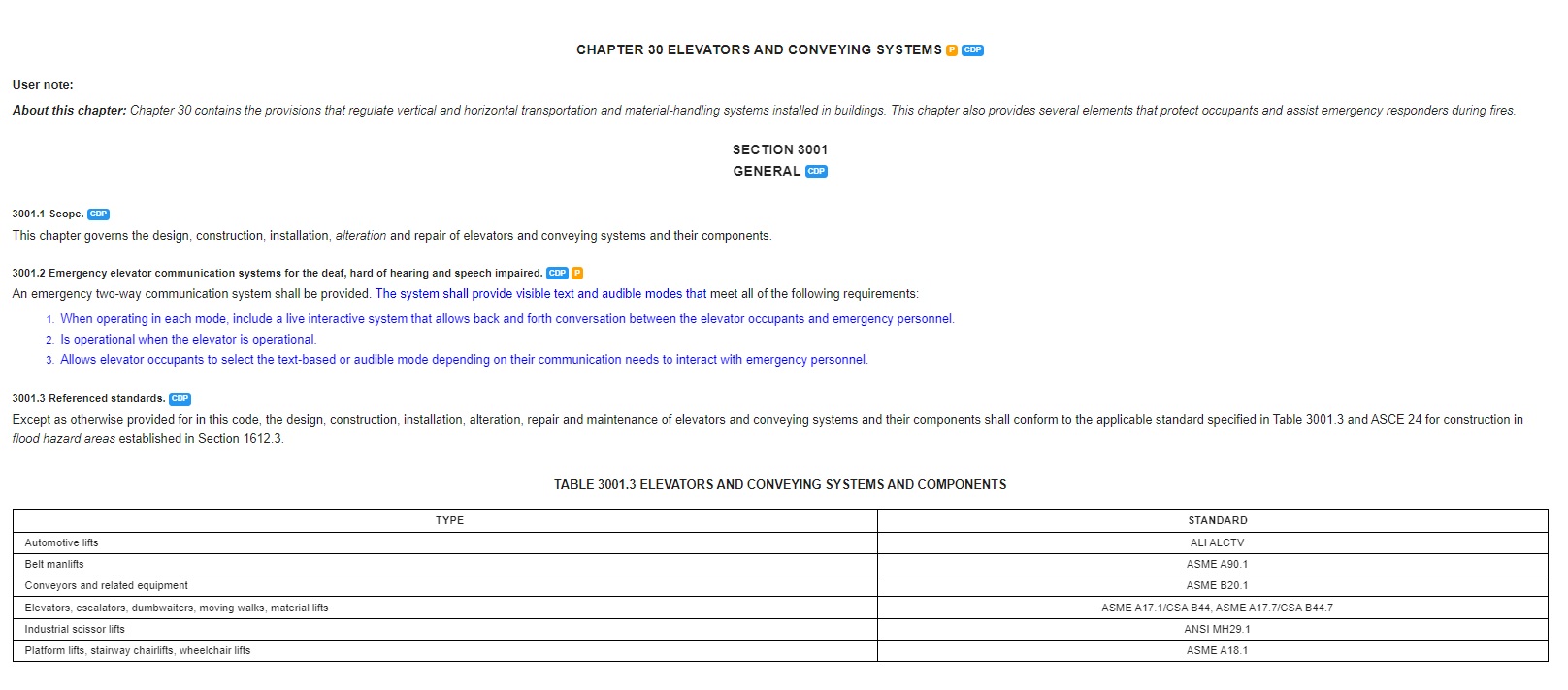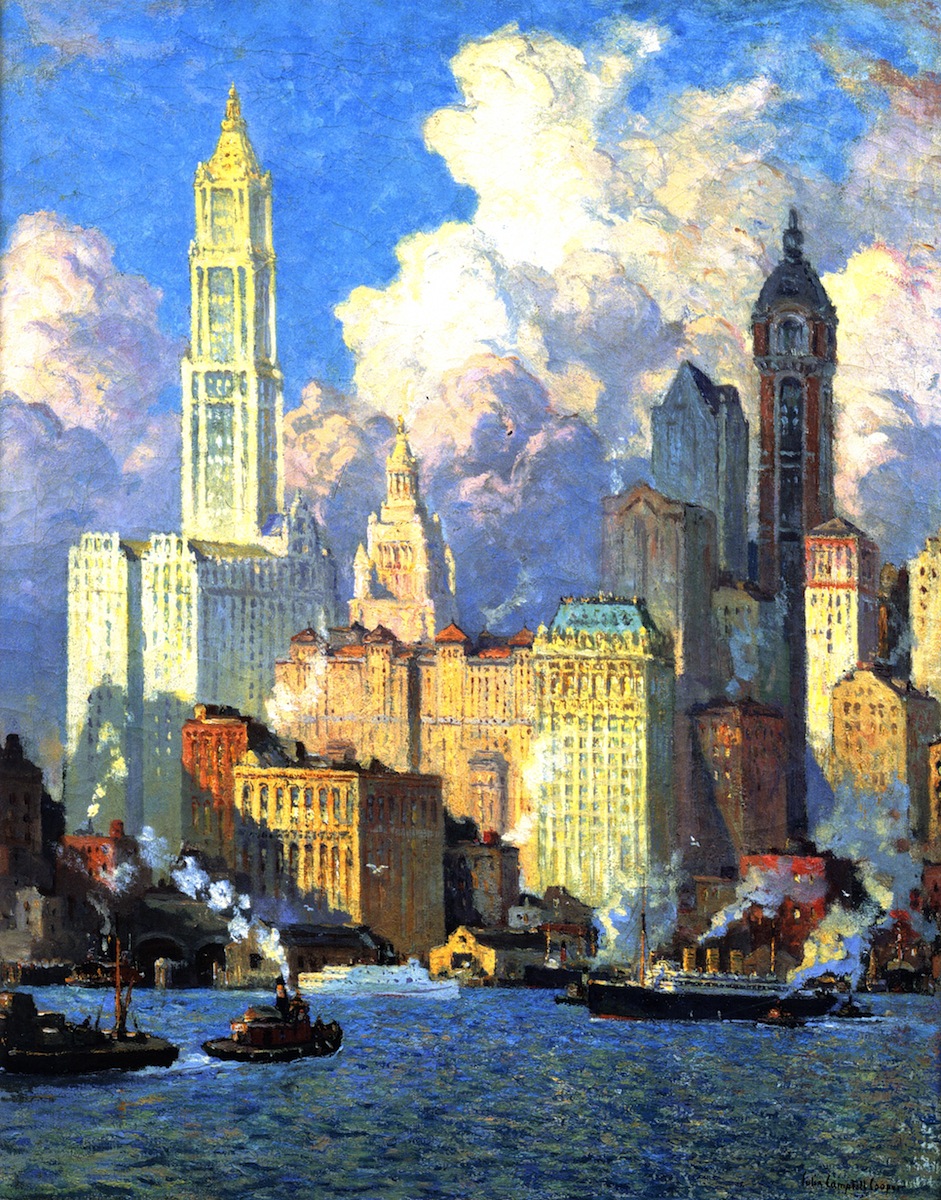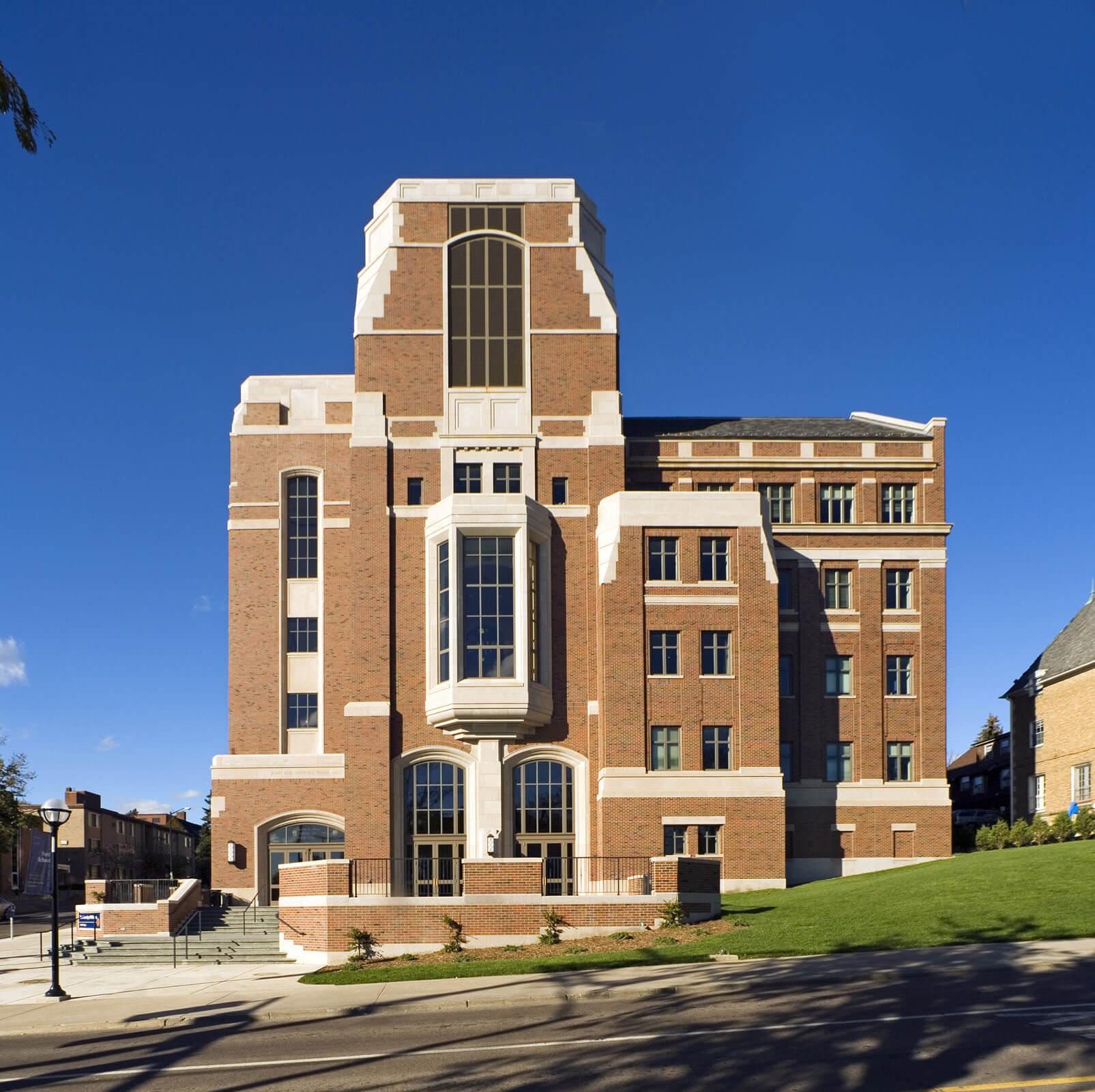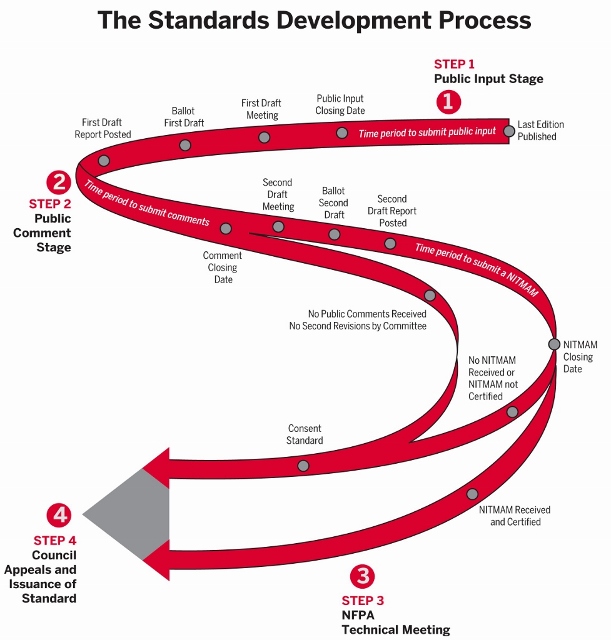Author Archives: mike@standardsmichigan.com
- Home
- Articles posted by mike@standardsmichigan.com (Page 16)

Elevators and Conveying Systems
Latest 2024 / 2025 / 2026 Code Development: Group B Documents
Partial selection of topics:
ADM39-25 IFC: 105.6.26 (New) | p 224
G52-25 403.6.1 Fire service access elevator | p 556
SECTION 3003 EMERGENCY OPERATIONS | p 557
TABLE 403.6.1 AMBULANCE STRETCHER-SIZED ELEVATOR CAR
Add new standards EN 8, EN 77 (Seismic condition design) and ISO 8002 | p 758
SECTION 3006 ELEVATOR LOBBIES AND HOISTWAY OPENING PROTECTION | p 762
3002.3 Emergency signs | p 765
3002.4 Elevator car to accommodate ambulance stretcher. | p 774
(To be continued)
Variations in Backup Power Requirements for Elevators
Group B Proposed Changes 2024 Editions Complete Monograph (2630 Pages)
The International Code Council bibliography of elevator safety practice incorporates titles published by American Society of Mechanical Engineers, the National Fire Protection Association and the Institute of Electrical and Electronic Engineers. The relevant section of the International Building Code is therefore relatively short and linked below.
2021 International Building Code: Chapter 30 Elevators and Conveying Systems
The 2021 IBC is the current edition but committees are now forming to developed the 2024 revision according to the schedule in the link below:
2024/2025/2026 ICC CODE DEVELOPMENT SCHEDULE
2024 GROUP A PROPOSED CHANGES TO THE I-CODES
Comments on changes to the Group A tranche of titles will be heard in Long Beach California, October 23-31st.
![]()
Elevator Safety Code
Elevator, escalator and moving walk systems are among the most complicated systems in any urban environment, no less so than on the #WiseCampus in which many large research universities have 100 to 1000 elevators to safely and economically operate, service and continuously commission. These systems are regulated heavily at state and local levels of government and have oversight from volunteers that are passionate about their work.
These “movement systems” are absorbed into the Internet of Things transformation. Lately we have tried to keep pace with the expansion of requirements to include software integration professionals to coordinate the interoperability of elevators, lifts and escalators with building automation systems for fire safety, indoor air quality and disaster management. Much of work requires understanding of the local adaptations of national building codes.
Some university elevator O&M units use a combination of in-house, manufacturer and standing order contractors to accomplish their safety and sustainability objectives.
In the United States the American Society of Mechanical Engineers is the dominant standards developer of elevator and escalator system best practice titles; its breakdown of technical committees listed in the link below:
C&S Connect: ASME Proposals Available for Public Review
Public consultation on a new standard for electrical inspector qualifications closes May 27th.
ASME A17.7/CSA B44.7 – 20XX, Performance-based code for elevators and escalators (280 pages)
Safety Code for Existing Elevators and Escalators
Guide for Inspection of Elevators, Escalators, and Moving Walks
Guide for Elevator Seismic Design
As always, we encourage facility managers, elevator shop personnel to participate directly in the ASME Codes & Standards development process. For example, it would be relatively easy for our colleagues in the Phoenix, Arizona region to attend one or more of the technical committee meetings; ideally with operating data and a solid proposal for improving the A17 suite.
All ASME standards are on the agenda of our Mechanical, Pathway and Elevator & Lift colloquia. See our CALENDAR for the next online teleconferences; open to everyone. Use the login credentials at the upper right of our home page.
Issue: [11-50]
Category: Electrical, Elevators, #WiseCampus
Colleagues: Mike Anthony, Jim Harvey, Richard Robben, Larry Spielvogel
More:
Bibliography: Elevators, Lifts and Moving Walks
ISO/TC 178 Lifts, escalators and moving walks
Eccles Cakes
This content is accessible to paid subscribers. To view it please enter your password below or send mike@standardsmichigan.com a request for subscription details.
Cafe Crawl
Statement of Net Position 2024: $685,683 (000) | Leadership Organization | Master Plan
Bryant University is elated to announce that the Bulldog Community has earned a prestigious five-star excellence rating from @QSCorporate Quacquarelli Systems, affirming Bryant’s place among the elite institutions of higher education worldwide. This comprehensive evaluation,… pic.twitter.com/0XzixVQbiN
— Bryant University (@BryantUniv) February 4, 2025
Power Distribution Units
Today we veer (slightly) from our primary interest in interoperability standards to explore the moment in best practice discovery and promulgation in the hardware supporting the artificial intelligence zietgeist. Use the login credentials at the upper right of our home page.
Carnegie-Mellon: Planning & Design Considerations for Data Centers
University of Kansas Data Center and Server Room Standards
Power Distribution Units (PDUs) are critical in data centers, serving as the backbone for reliable power management. They distribute electricity from the main power source to servers, networking equipment, and other devices, ensuring consistent and stable power delivery.
PDUs offer features like load balancing, surge protection, and remote monitoring, which optimize energy efficiency and prevent outages. By providing multiple outlets and circuit protection, they safeguard expensive equipment from power fluctuations. Advanced PDUs enable real-time data tracking, aiding in capacity planning and fault detection.
Ultimately, PDUs ensure uptime, operational efficiency, and scalability in data centers. We track, and sometimes participate, in the standards setting for these organizations develop the key standards that govern PDU design, safety, efficiency, and interoperability, influencing global manufacturing compliance:
UL (Underwriters Laboratories): Establishes safety standards like UL 60950-1 for IT equipment, ensuring PDUs prevent hazards in high-density environments.
IEC (International Electrotechnical Commission): Develops core electrical standards such as IEC 60950-1 and IEC 62368-1 for low-voltage safety and audio/video/IT equipment, critical for PDU power handling.
ENERGY STAR (U.S. EPA): Sets efficiency benchmarks for PDUs, promoting low-loss designs to minimize data center energy waste (up to 12% savings).Related:
Power Management For Data Centers Challenges And Opportunities
TIA 92
Uptime Institute
Related:
“What Happens When Data Centers Come to Town”
What Happens When Data Centers Come to Town
Terry Nguyen | BA Public Policy
Ben Green |Assistant Professor, School of Information and Gerald R. Ford School of Public Policy
Partner | Michigan Environmental Justice Coalition
Introduction. [Abstract]. The rapid growth of data centers, with their enormous energy and water demands, necessitates targeted policy interventions to mitigate environmental impacts and protect local communities. To address these issues, states with existing data center tax breaks should adopt sustainable growth policies for data centers, mandating energy audits, strict performance standards, and renewable energy integration, while also requiring transparency in energy usage reporting. “Renewable energy additionality” clauses should ensure data centers contribute to new renewable capacity rather than relying on existing resources. If these measures prove insufficient, states should consider repealing tax breaks to slow unsustainable data center growth. States without tax breaks should avoid such incentives altogether while simultaneously implementing mandatory reporting requirements to hold data centers accountable for their environmental impact. Broader measures should include protecting local tax revenues for schools, regulating utility rate hikes to prevent cost-shifting to consumers, and aligning data center energy demands with state climate goals to avoid prolonging reliance on fossil fuels.
Related:
Sharan Kalwani (Chair, Southeast Michigan Section IEEE): AI and Data Center Demand
2029 National Electrical Code
Public input on the 2029 Revision will be received until April 9th. Over the next weeks and months — typically meeting twice a day every Tuesday — we will pull forward our previous proposals and draft original proposals relevant to the education and healthcare electrotechnical infrastructure of educational settlements. Link to Proposed Reorganization.
Photo at 2723 State Street Office*
Mike was part of the National Electrical Code Quarter Century Club but was at another conference and not able to receive the award at the June conference. University of Michigan support began in 1993. IEEE support began in 2014.
*New Office (a short walk across the street) starting October 1: 455 East Eisenhower, Ann Arbor, MI 48108
Current Issues and Recent Research
Today we examine Second Draft transcripts of the Special Equipment Chapter 6 (CMP-12) and product inspection, testing and certification listings that appear Annex A (CMP-1).
Once every eighteen months we spend a week drilling into the National Electrical Code by submitting new proposals or comments on proposed revisions. Today we review the actions taken by the technical committees on the First Draft. Responses to committee actions will be received until August 26th.
Interconnected Electric Power Production Sources “Microgrids”
New update alert! The 2022 update to the Trademark Assignment Dataset is now available online. Find 1.29 million trademark assignments, involving 2.28 million unique trademark properties issued by the USPTO between March 1952 and January 2023: https://t.co/njrDAbSpwB pic.twitter.com/GkAXrHoQ9T
— USPTO (@uspto) July 13, 2023
Standards Michigan Group, LLC
2723 South State Street | Suite 150
Ann Arbor, MI 48104 USA
888-746-3670




















